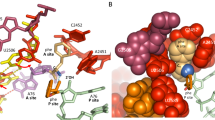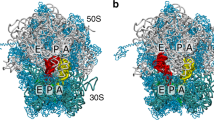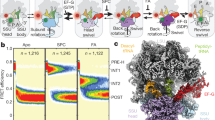Abstract
Upon transpeptidylation, the 3′ end of aminoacyl-tRNA (aa-tRNA) in the ribosomal A site enters the A/P hybrid state. We report that transpeptidylation of Phe-tRNA to fMetPhe-tRNA on Escherichia coli ribosomes substantially lowers the kinetic stability of the ribosome–tRNA complex and decreases the affinity by 18.9 kJ mol−1. At the same time, the free energy of activation of elongation factor G dependent translocation decreases by 12.5 kJ mol−1, indicating that part of the free energy of transpeptidylation is used to drive translocation kinetically. Thus, the formation of the A/P hybrid state constitutes an important element of the translocation mechanism.
This is a preview of subscription content, access via your institution
Access options
Subscribe to this journal
Receive 12 print issues and online access
$189.00 per year
only $15.75 per issue
Buy this article
- Purchase on Springer Link
- Instant access to full article PDF
Prices may be subject to local taxes which are calculated during checkout





Similar content being viewed by others
References
Pape, T., Wintermeyer, W. & Rodnina, M.V. EMBO J. 17, 7490– 7497 (1998).
Moazed, D. & Noller, H.F. Nature 342, 142–148 (1989).
Semenkov, Y.P., Rodnina, M.V. & Wintermeyer, W. Proc. Natl. Acad. Sci. USA 93, 12183–12188 (1996).
Wintermeyer, W., Lill, R. & Robertson, J.M. In The Ribosome. Structure, function, and evolution. (eds, Hill, W.E., et al.) 348– 357 (American Society for Microbiology, Washington, D.C.; 1990).
Wagner, E.G.H., Jelenc, P.C., Ehrenberg, M. & Kurland, C.G. Eur. J. Biochem. 122, 193– 197 (1982).
Lill, R., Robertson, J.M. & Wintermeyer, W. Biochemistry 25, 3245– 3255 (1986).
Rodnina, M.V., Savelsbergh, A., Katunin, V.I. & Wintermeyer, W. Nature 385, 37–41 ( 1997).
Paulsen, H. & Wintermeyer, W. Biochemistry 25, 2749–2756 (1986).
Dixon, M. & Webb, E.C. Enzymes (Academic Press, New York, San Francisco; 1979).
Moazed, D. & Noller, H.F. Cell 57 , 585–597 (1989).
Green, R., Switzer, C. & Noller, H.F. Science 280, 286– 289 (1998).
Kim, D.F. & Green, R. Mol. Cell 4, 859–864 (1999).
Noller, H.F., Hoffrath, V. & Zimniak, L. Science 256, 1416– 1419 (1992).
Samaha, R.R., Green, R. & Noller, H.F. Nature 377, 309– 314 (1995).
Lill, R., Robertson, J.M. & Wintermeyer, W. EMBO J. 8, 3933– 3938 (1989).
Berg, P., Bergmann, F.H., Ofengand, E.J. & Dieckmann, M. J. Biol. Chem. 236, 1726–1734 (1961).
Leahy, J., Glassman, E. & Schweet, R.S. J. Biol. Chem. 235, 3209– 3212 (1960).
Papas, T.S. & Peterkofsky, A. Biochemistry 11, 4602–4608 (1972).
Jencks, W.P. & Gilchrist, M. J. Am. Chem. Soc. 86, 4651–4654 ( 1964).
Moazed, D. & Noller, H.F. J. Mol. Biol. 211, 135–145 (1990).
Stark, H., et al. Cell 88, 19–28 (1997).
Stark, H., et al. Nature 389, 403–406 (1997).
Schilling-Bartetzko, S., Franceschi, F., Sternback, H. & Nierhaus, K.H. J. Biol. Chem. 267, 4693– 4702 (1992).
Kirillov, S.V. & Semenkov, Y.P. FEBS Lett. 148, 235–238 ( 1982).
Rodnina, M.V., et al. Proc. Natl. Acad. Sci. USA 96, 9586 –9590 (1999).
Acknowledgements
We thank C. Gualerzi for strains overproducing initiation factors, V. Makhno for purified tRNAs, and P. Striebeck and S. Möbitz for expert technical assistance. The work was supported by the Deutsche Forschungsgemeinschaft, the Volkswagen-Stiftung, the European Union, the Alfried Krupp von Bohlen und Halbach-Stiftung, and the Fonds der Chemischen Industrie.
Author information
Authors and Affiliations
Corresponding author
Rights and permissions
About this article
Cite this article
Semenkov, Y., Rodnina, M. & Wintermeyer, W. Energetic contribution of tRNA hybrid state formation to translocation catalysis on the ribosome. Nat Struct Mol Biol 7, 1027–1031 (2000). https://doi.org/10.1038/80938
Received:
Accepted:
Issue Date:
DOI: https://doi.org/10.1038/80938
This article is cited by
-
Ribosome selectivity and nascent chain context in modulating the incorporation of fluorescent non-canonical amino acid into proteins
Scientific Reports (2022)
-
Messenger RNA interactions in the decoding center control the rate of translocation
Nature Structural & Molecular Biology (2011)
-
Aminoglycoside activity observed on single pre-translocation ribosome complexes
Nature Chemical Biology (2010)
-
Insights into substrate stabilization from snapshots of the peptidyl transferase center of the intact 70S ribosome
Nature Structural & Molecular Biology (2009)
-
Peptide bond formation destabilizes Shine–Dalgarno interaction on the ribosome
Nature (2007)



